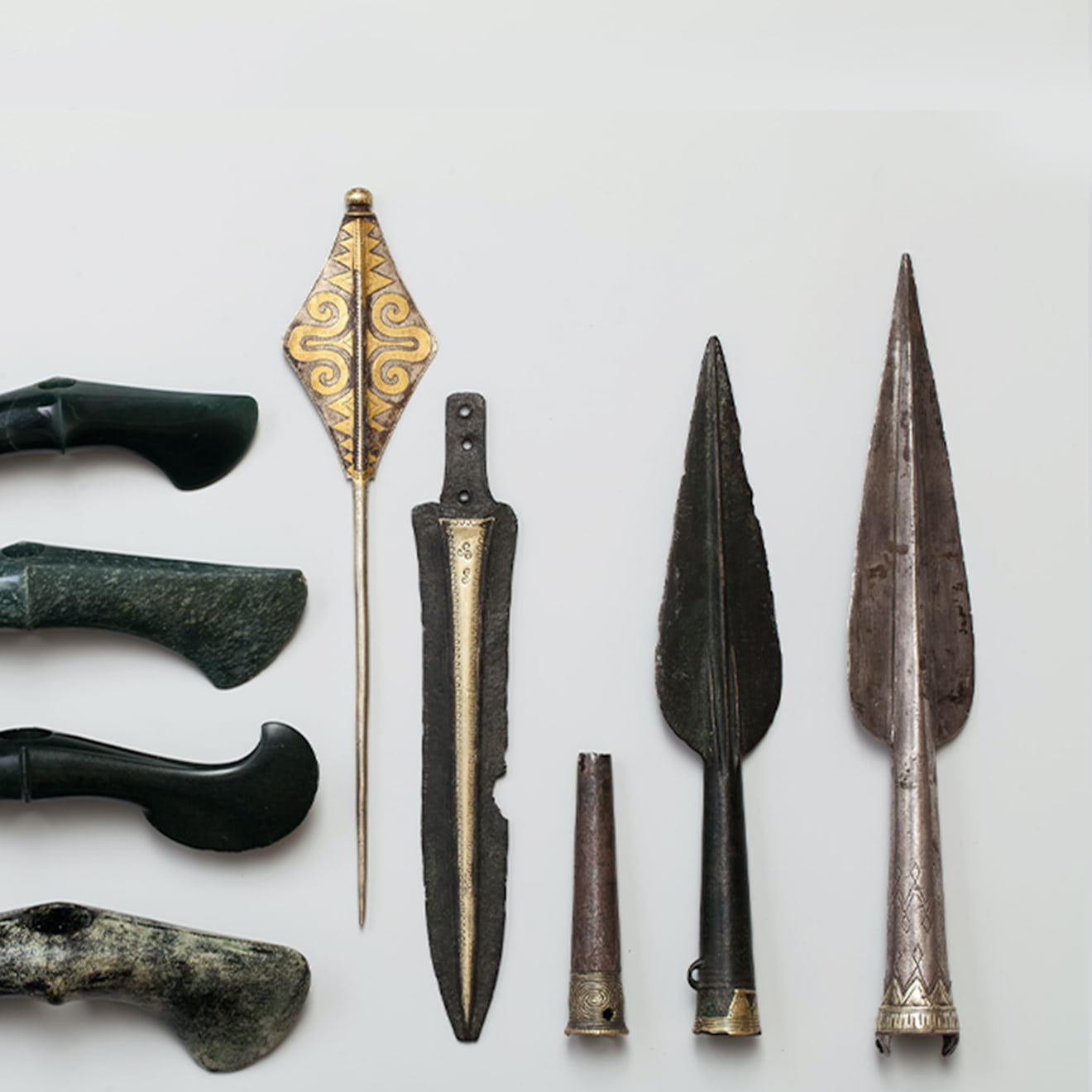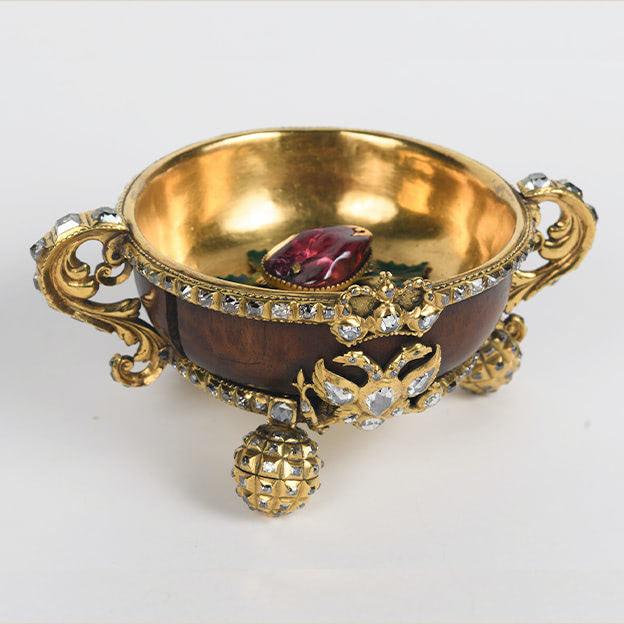

-
Borodinohoard
XVIII–XVII c. B.C.
Bessarabian governorate, Akkerman district, Borodino village; coincidental finding
Silver, gold, bronze, nephrite, serpentine, soapstone
Accession: in 1923 from the Museum of fine arts
The hoard from Borodino is one of the most well-known hoards dated back to the II millennium B.C. It was found in 1912 by the peasants who were quarrying stone from small-sized mounds.
Thehoardconsistsoftwosilverspearheadsandone spear socket, silver dagger and golden pin, four stone axes and three maceheads as well as three fragments of axes, two ceramic fragments and two bronze plates. The delicately shaped, qualitatively finished stone axes can be only compared to the ones found by Heinrich Schliemann while excavating the legendary Troy. DarkgreennephriteusedtoproducetheaxesfromBorodinowas mined in the Western and Eastern Sayans. Thedistancebetweenthemineral deposit and the place of finding goes up to several thousands of kilometres. Itisstillbeing discussed, who could produce these amazing artefacts,which look more like pieces of art than everyday items, and how among the treasures there appeared the dress dagger decorated with a golden ornamented onlay and the golden pin that strongly resemble the mysterious symbols of power of the Creto-Mycenean warriors.

-
Cup
Moscow. 1709. Setting – 1709–1720.
Gold, diamonds, spinelrubies, enamel, walnutknag; carving, stamping
Height– 5,5 cm. Diameter – 7,5 cm
Accession: in 1932 wasacquiredinTorgsin (theAll-Unionassociationontradewithforeigners, commercialSyndicate) inexchangeforsome tableware from the Special storage of the SHM
The cup was made by emperor Peter 1 and granted to Moscow governor prince Matwei Gagarin, who put it in a specially ordered splendid setting made of red gold and 350 rough and cut diamonds.
On the outer side of the bottom there are two inscriptions - one of them is in Russian and says "1709. ThisistheitemcraftedbyPeterAlekseevych, theGreatEmperorofRussia", the second one is in French and can be translated in the following way: "granted to PrinceMatweiPetrovich Gagarin in celebration of Poltava victory". Thecupwasarewardgivenforthesumptuouscelebrationarrangedin tribute to Russian victory in the Battle of Poltava of 1709.
LaterMatweiGagarinwasappointed to the post of the governor of Siberia, however, in April 1721 he was arrested and executed for "abuse of authority and concealmentof accomplices", among which there was Prince Alexander Menshikov.

-
Taman sarcophagus
LateIV- earlyIIIcentury B.C.
Taman peninsula, Taman Cossack village
The sarcophagus was found on Lysaya Gora (mountain) on the Taman peninsula. Thisfive-tonsarcophagusmadeofmonolithic marble in the form of an ancient church was produced in Asia Minor. Originallyit was decorated with a bright ornamental pattern; the centres of the rosettes were gilded, and the background in the niches was painted pink. Theburial vault it was found in was a family crypt, and, in accordance with the form of the shrine - a simple stone box with a flat overlapping - it served as a burial place for the members of the Hellenised local nobility.
Taman sarcophagus is acknowledged by UNESCO as a monument of the world's culture - and still graces the exposition of the State Historical museum.

-
Vladimir Lenin's Rolls-Royce
The State Historical Museum displays a car model "Silver ghost" produced by the British company "Rolls-Royce". This car was the one driven by Vladimir Lenin, the head of the world's first socialistic state, in the last days of his life. The car turned into a museum item only in 1939, three years after it was decided to create V.I. Lenin's Central Museum in Moscow. The search for the car started at once, though it was not quite successful at first.
It is known that Lenin acquired official cars after the October revolution of 1917, as it was required by the very status of the first person of the new-born Soviet state and the head of the Council of People's Commissars. The motor transport base of the Soviet government was organized on the basis of the Provisional Government, which, in its turn, brought into requisition the cars from the garage of His Imperial Majesty in February 1917. In early 1917 last Russian Tsar Nicholas II had about 40 cars of the world's most famous brands in his collection, of which there were some Rolls-Royce Silver Ghosts. The confiscated cars from the imperial garage joined the motor transport base of the Council of People's Commissars. The car displayed in the State Historical Museum is known to be ordered in Great Britain on July 11, 1922.
Thecostofthechassiswiththemotorcameupto 1850pounds sterling, besides, themotorwas sentforaspecialreworktoupgradeitsspeed, whichafterallaccessed 125kilometers per hour. Inlate 1922 thecarwastransportedtoRussiaandtookitsplaceintheSpecialGaragewithcitynumber 236. BythatmomentVladimirLeninwasspendingmostoftheyearinGorki where he moved tobecauseofa breakdown in his health. Inrareperiodsofgainsinhealth, VladimirLeninenjoyedcarrides, which, as his wife Nadezhda Krupskaya recalled, had a revulsive and calming effect on him. ThecarswerealsousedtogetthedoctorswhoweremonitoringLenin'shealth condition, numerous visitors, to deliver post and medicine.
